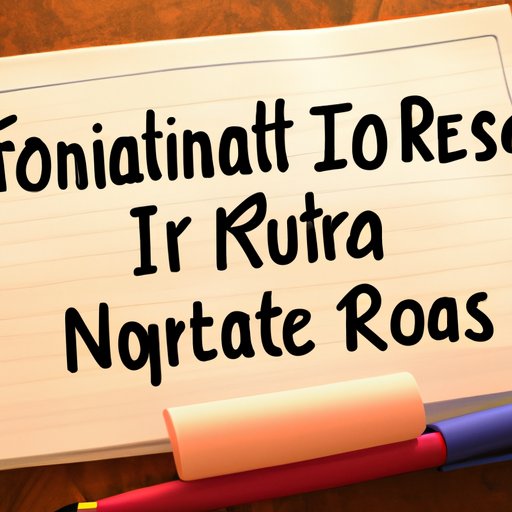Introduction
An Individual Retirement Account (IRA) is a type of investment vehicle that allows you to save for retirement by setting aside part of your income in a tax-advantaged account. IRAs are one of the most popular ways to save for retirement, providing a range of benefits that can help you build a secure financial future. In this article, we’ll explore the basics of an IRA, including eligibility requirements, contribution limits, tax advantages, and different types of accounts. We’ll also discuss strategies for making the most out of your IRA contributions and taking advantage of tax benefits.
Explaining the Basics: What is an IRA and How Does it Work?
An IRA is a type of investment account that allows you to set aside a portion of your income for retirement. The money in your IRA grows tax-free until you begin taking distributions at age 59 ½ or older. At that point, you’ll pay taxes on any withdrawals you make from the account. Depending on the type of IRA you have, you may also be eligible for other tax benefits.
In order to open an IRA, you must meet certain eligibility requirements. Generally, you must be under 70 ½ years old and have earned income to contribute to the account. You cannot contribute to an IRA if you have reached the IRS’s maximum annual contribution limit for the year. This limit varies depending on your age, filing status, and other factors, so it’s important to check with the IRS to determine your exact contribution limit.
It’s also important to understand the tax implications of investing in an IRA. Contributions to a traditional IRA are typically tax-deductible, while contributions to a Roth IRA are made with after-tax dollars. Any earnings you make in the account grow tax-free, and when you begin taking distributions, you’ll only pay taxes on the amount you withdraw. It’s important to note that there may be penalties for early withdrawals from an IRA, so you should always consult a financial advisor before accessing your funds.
Comparing IRAs to 401(k)s and Other Retirement Accounts
When it comes to retirement savings, many people are familiar with 401(k) plans. A 401(k) is employer-sponsored and offers tax-deferred contributions up to a certain limit. It’s important to note that 401(k)s are subject to a variety of rules and restrictions, such as vesting periods, employer matches, and loan provisions. IRAs, on the other hand, are individual accounts that don’t require employer sponsorship. They also offer more flexibility in terms of contribution limits and withdrawal rules.
Another type of retirement account is a Traditional IRA. This type of IRA allows you to make pre-tax contributions up to a certain limit each year. Any earnings you make in the account are tax-deferred until you begin taking withdrawals. Withdrawals are also subject to income tax, but you may be able to take a tax deduction for some or all of your contributions.
Roth IRAs are another type of retirement account that offer tax-free growth and tax-free withdrawals at retirement. Unlike traditional IRAs, contributions to a Roth IRA are made with after-tax dollars, so you won’t get an immediate tax break. However, you’ll still benefit from tax-free growth and tax-free withdrawals in retirement.
Finally, there are SEP IRAs and SIMPLE IRAs. These are employer-sponsored retirement accounts that allow employers to make contributions on behalf of their employees. SEP IRAs are best suited for self-employed individuals and small business owners, while SIMPLE IRAs are best suited for employees of larger companies. Both of these types of accounts offer tax-deferred growth and tax-free withdrawals at retirement.

Making the Most Out of Your IRA Contributions
Once you’ve opened an IRA, you’ll need to decide how to invest your money. Investing for growth is key to maximizing the benefits of your IRA. You can do this by diversifying your investments across different asset classes, such as stocks, bonds, and cash. You may also want to consider taking advantage of employer matches, if available, to get the most out of your contributions.

Taking Advantage of Tax Benefits with an IRA
One of the main benefits of investing in an IRA is the potential to take advantage of tax benefits. Depending on the type of IRA you have, you may be able to deduct your contributions from your taxable income, enjoy tax-deferred growth, and even take tax-free distributions in retirement. It’s important to understand the tax implications of each type of IRA, as well as any other retirement accounts you may have, in order to maximize your tax savings.

Deciding When to Take IRA Distributions
When it comes time to take distributions from your IRA, you’ll need to understand the rules and regulations around withdrawals. Generally, you can begin taking distributions from your IRA at age 59 ½ without incurring any penalty. However, if you take distributions before that age, you may be subject to a 10% penalty. Additionally, once you turn 70 ½, you’ll be required to begin taking Required Minimum Distributions (RMDs) from your IRA.
Maximizing Your IRA Benefits with the Right Investment Strategy
To maximize the benefits of your IRA, it’s important to develop a sound investment strategy. Asset allocation is key to successful investing, as is rebalancing your portfolio on a regular basis. You may also want to consider seeking advice from a financial professional to ensure you’re making the most out of your IRA contributions.
Conclusion
An IRA is a great way to save for retirement and take advantage of tax benefits. By understanding the basics of an IRA, comparing it to other retirement accounts, and developing a sound investment strategy, you can make the most out of your IRA contributions. As you plan for retirement, it’s important to understand the rules and regulations around IRA contributions and distributions, as well as the tax implications of investing in an IRA. With the right strategy, you can maximize the benefits of your IRA and secure a comfortable retirement.
(Note: Is this article not meeting your expectations? Do you have knowledge or insights to share? Unlock new opportunities and expand your reach by joining our authors team. Click Registration to join us and share your expertise with our readers.)
